I’m Graham Cranfield, and I’m an illustrator and game designer from Richmond, Virginia, USA. Game design is something I can only do on the side for now, and I think I prefer it not ever becoming a job. I always feel the need to create something, be it a drawing or a set of rules, and it’s much easier to do both of those things when it’s entirely for fun.
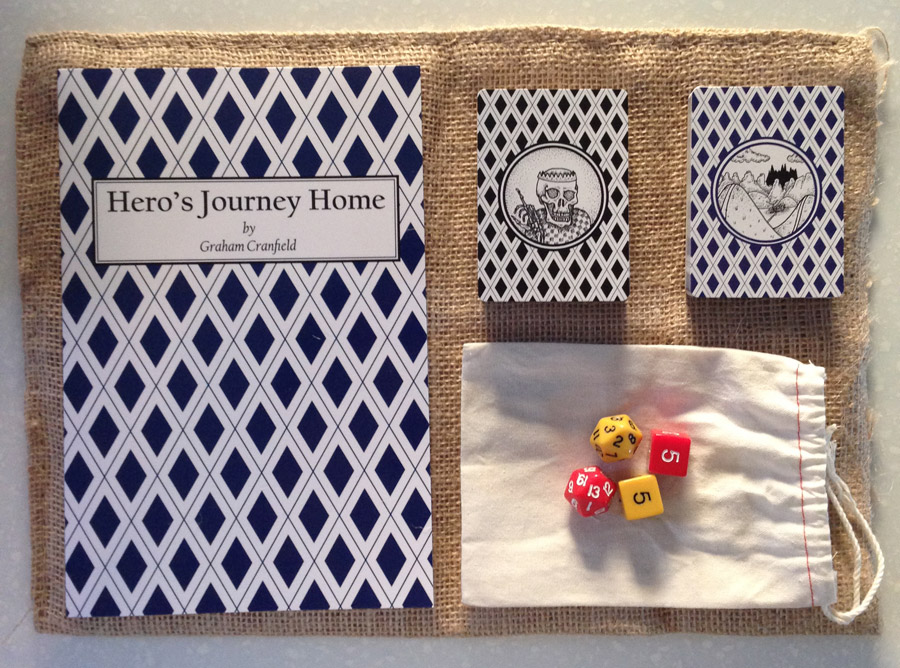
I began working on what would become Hero’s Journey Home back in early 2014. I initially had wanted to create a modified Rock-Paper-Scissors, basically a themed version of the game with some additional modifiers to downplay the luck factor and give some variation. There were various fantasy/RPG character types you could choose from and they had different attack strengths. Additionally, the combat would take place at various locations which would affect the gameplay as well.
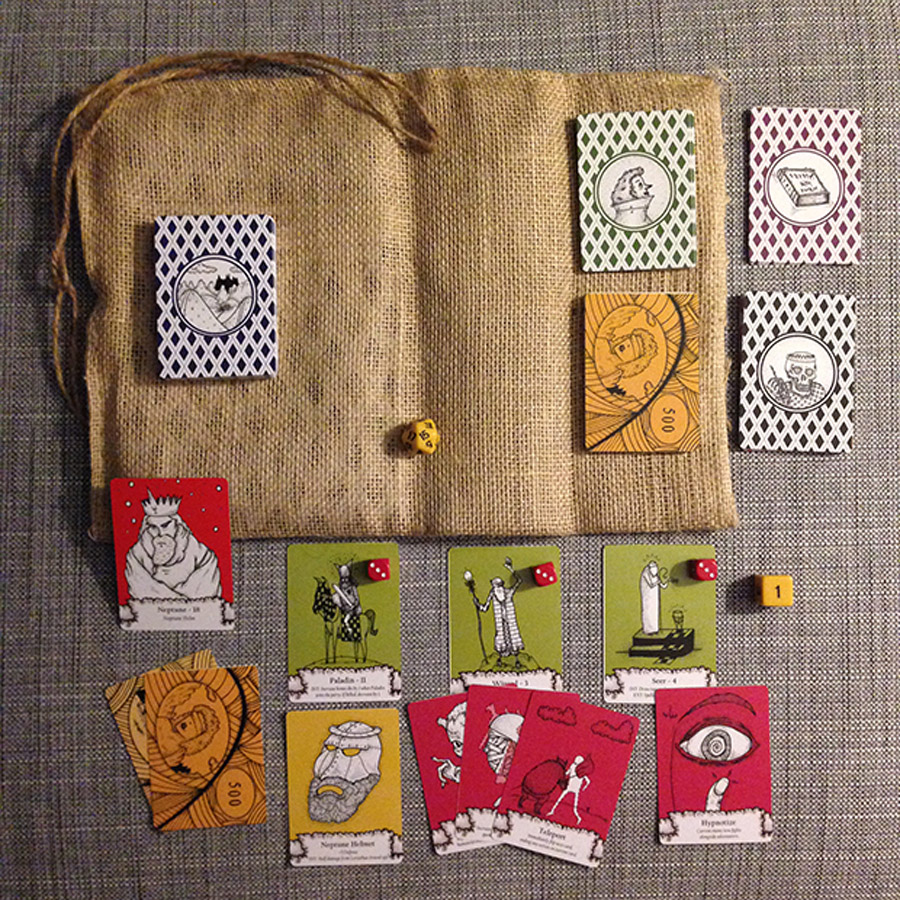
The more locations and characters I added, I realized that instead of having it just be a game of player vs player combat, it could instead be an actual adventure. This led into trying to figure out the overarching goal which would remain constant while the internals of the game were variable.
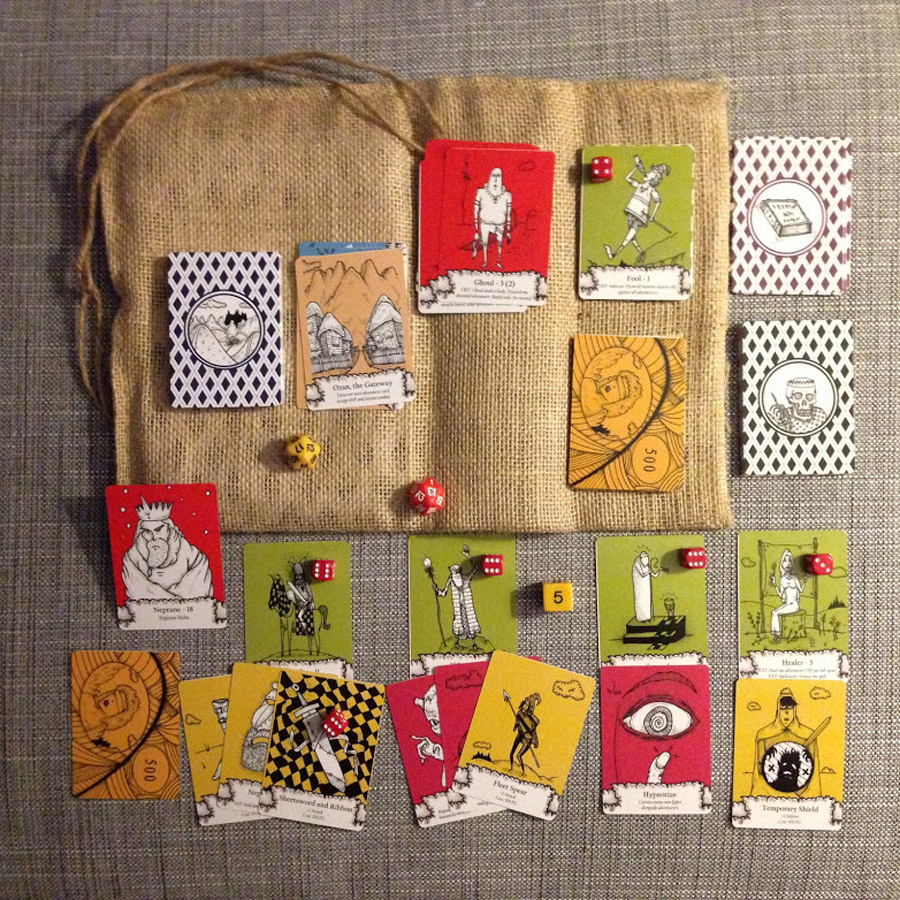
Having a definite end at a Home card solved the issue, for me, in a novel way. Starting at the end of the Quest I liked because it didn’t rely on a final boss fight. Once you beat the final boss, there’s not much incentive to play again; having enemies of varying strength shuffled throughout the deck means you never have the same path to victory. Mix in the locations, items, and (in two player games) player v player combat, and you have a robust mechanism for inviting replay.
The rest of the actual game mechanics and rules fell into place during playtesting. The combat system, the character actions, sort of the core mechanics of the game, changed considerably due to testing.
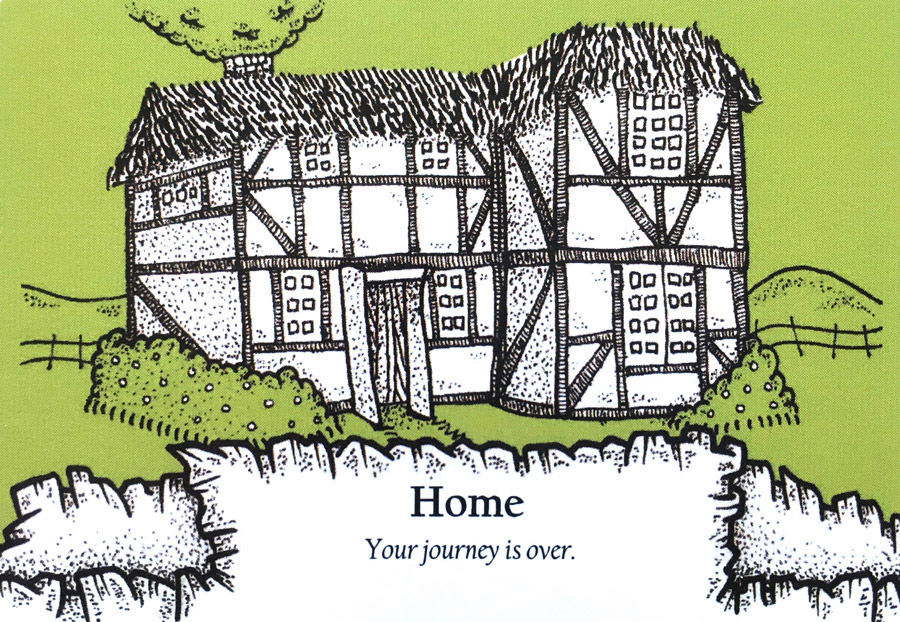
In combat, where originally the combat order was determined prior to battle, handing the player the choice of who is targeted by an enemy with every attack I felt added a nice psychological aspect to the game and it also eliminates luck as a deciding factor. There’s a lot of dice rolling in the combat portion of the game (which is mitigated by new rules in the first expansion), and I really wanted to confine that to hits, not who gets hit.
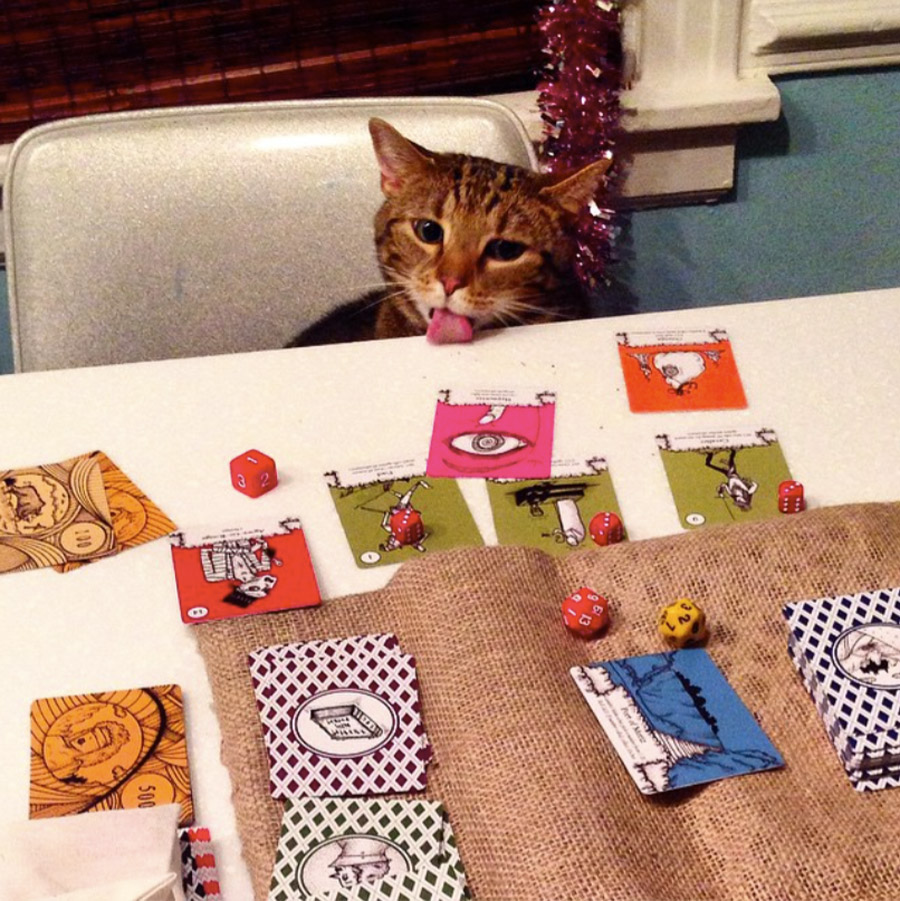
Character actions, too, were very limited or non-existent early on. It should have been obvious, but it wasn’t, that weak characters are the first to get the (literal) axe. So you’ll notice that even physically weak characters have powerful actions, and this has the knock-on effect of causing the player to funnel enemy attacks towards more powerful characters, which has a much more natural feel. You protect your wizards, and even your fools, because they can’t do it themselves.
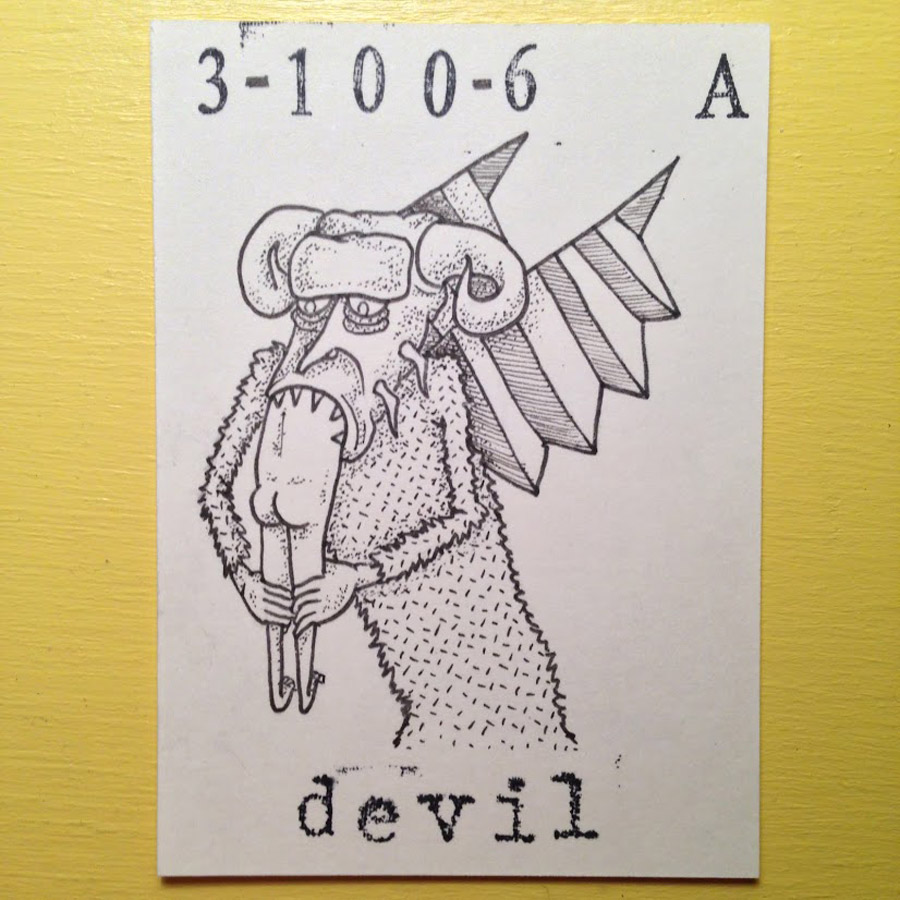
Visually, the original prototype game I created was vastly simpler than the final product. I really like the idea of a game where the cards just have a simple picture, or a picture with a word, like Tarot cards, and there’s this deep meaning and functionality behind them that the players already know.
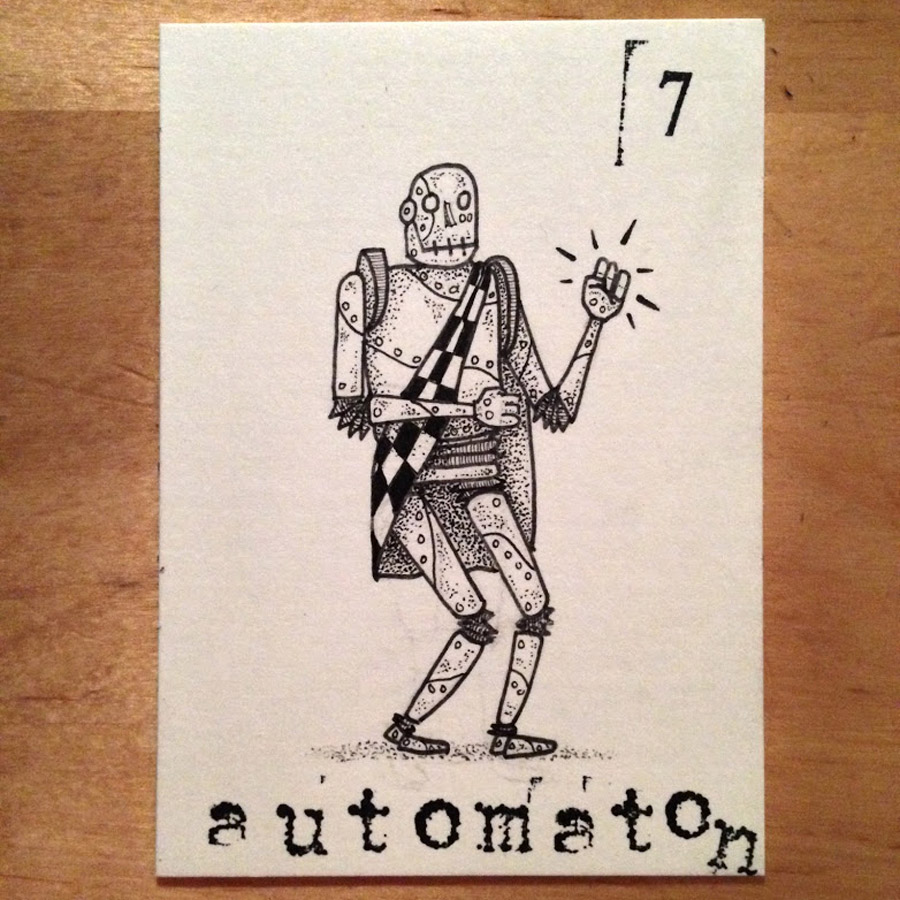
My illustrations, especially for the prototype, went in this direction. I drew the cards at full size and used little wooden stamps to add the name of the character/place/item along the bottom. I really wanted just that to be the final card. But, after testing, it was clear that wasn’t going to work. I still tried to minimize the text and make the rulebook an all-in-one reference, but you can’t just throw essentially blank cards at people and expect them to pick it up.
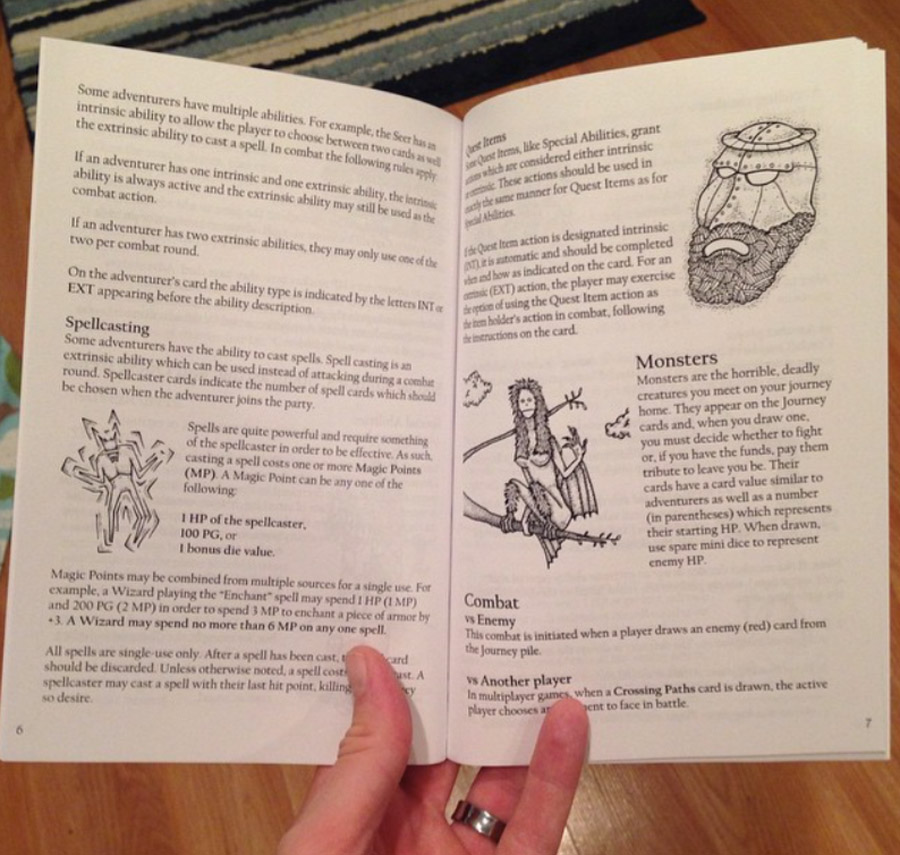
At the same time all of this is going on, since the entire game is a one-person operation, I’m trying to figure out the cheapest and most effective way to get all the parts and package the whole thing up.
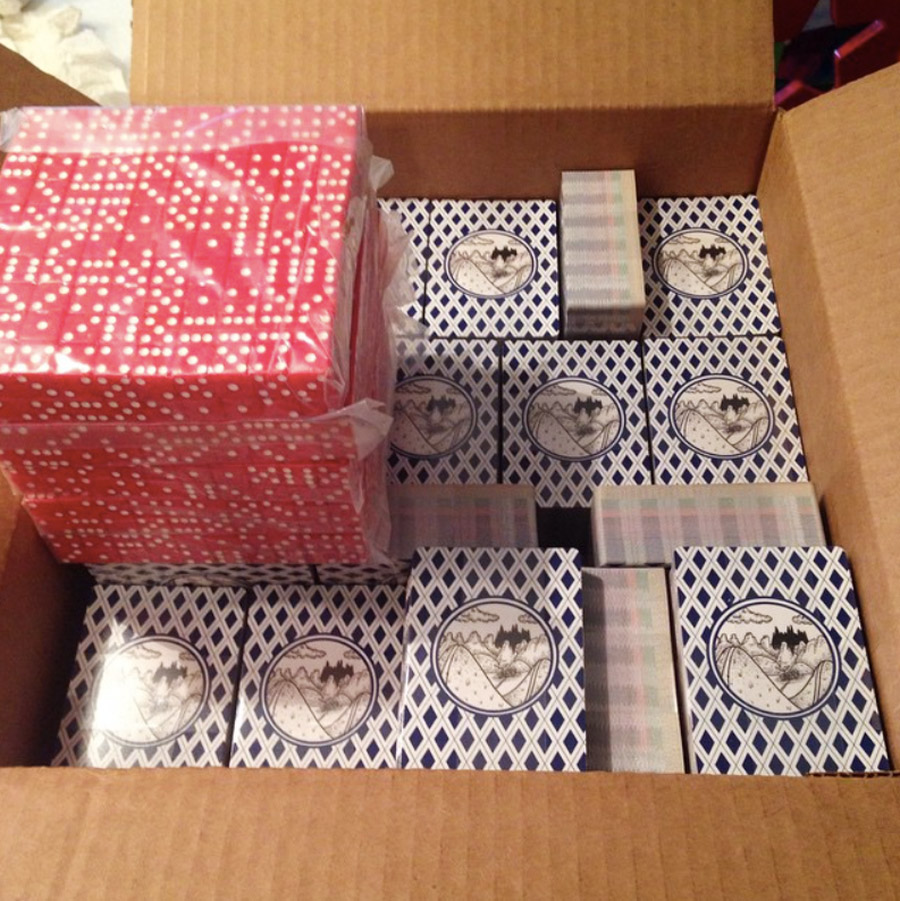
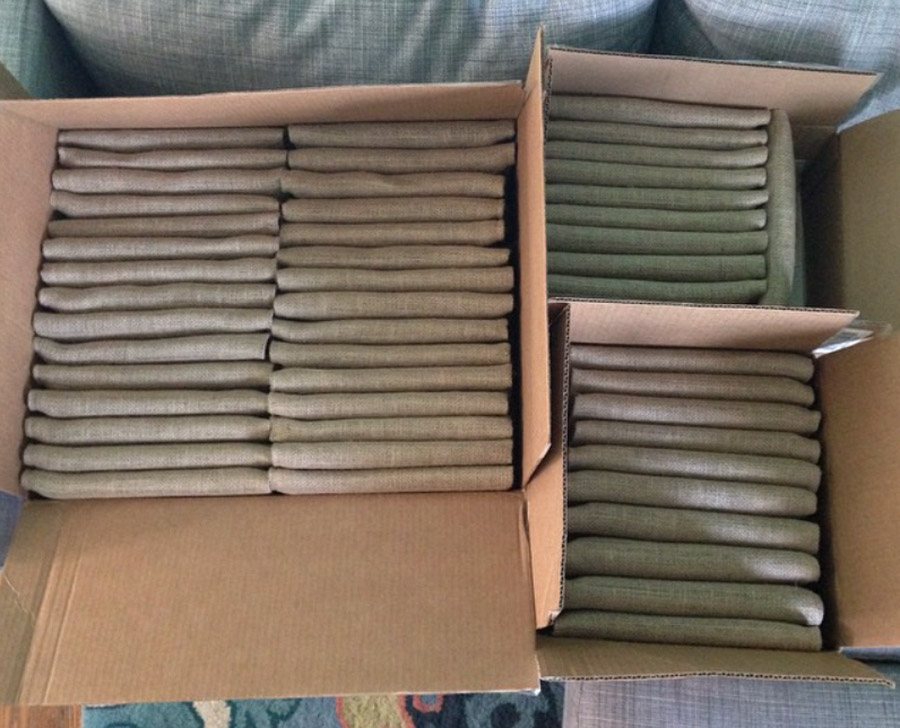
My wife, at the beginning, suggested using a bag of some sort. I really resisted that and thought surely a box would be easy to come by and not very expensive. I found out quickly that packaging is not cheap. It is incredibly expensive. Quality, custom game boxes especially are prohibitively expensive unless you’re ordering them in the thousands. So, on to a bag.
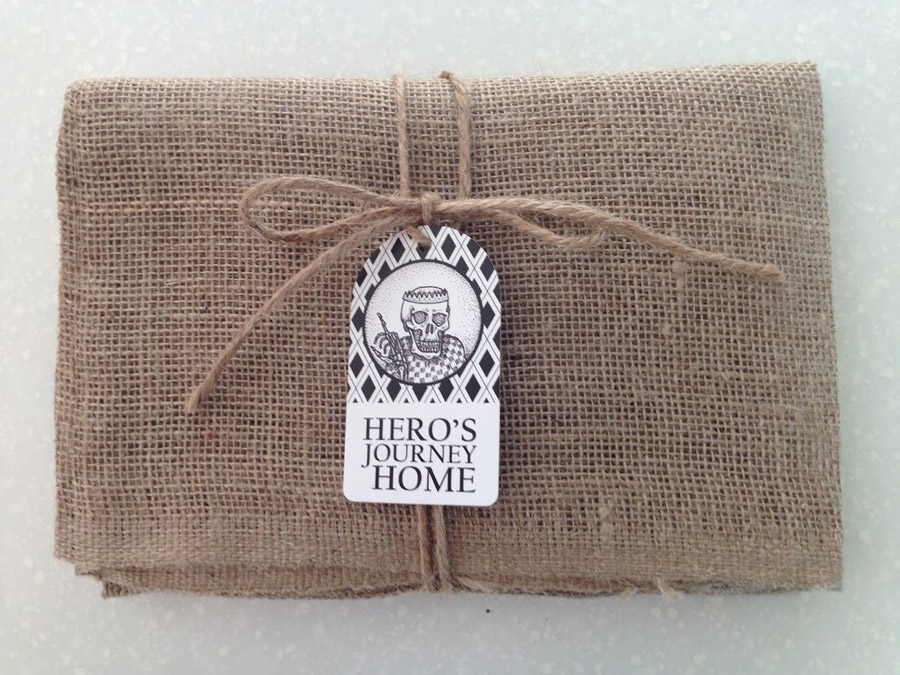
The burlap bag ended up being a great way to set the game apart and, nicely, it ties into the whole theme of the game. On the down side, it’s a huge pain to fill and it turns out it can be difficult to get the rulebook out, so, for future editions, I’m going smaller and boxier.
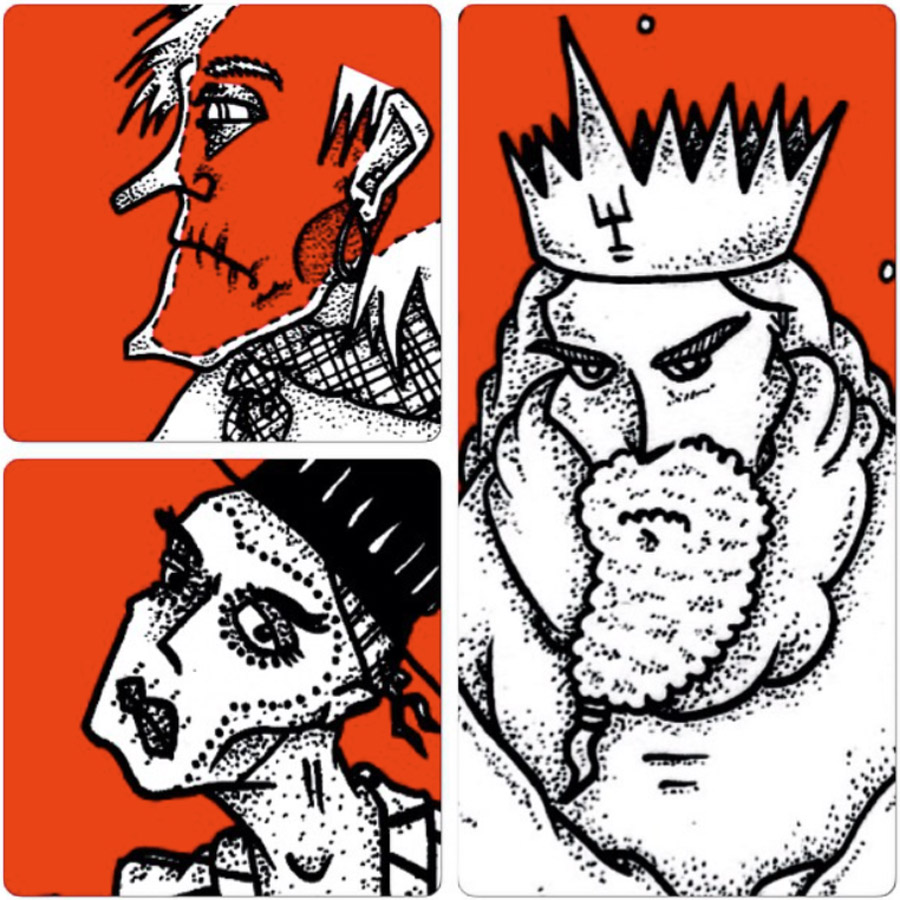
This being my first game, along with the fact that I’m not good with self-promotion (my wife drove most people to the Indiegogo campaign), meant the initial print didn’t go out to but 50 people. However, thanks to word of mouth, and good ratings and some nice reviews, I sold another 50 last year which sold me out completely.
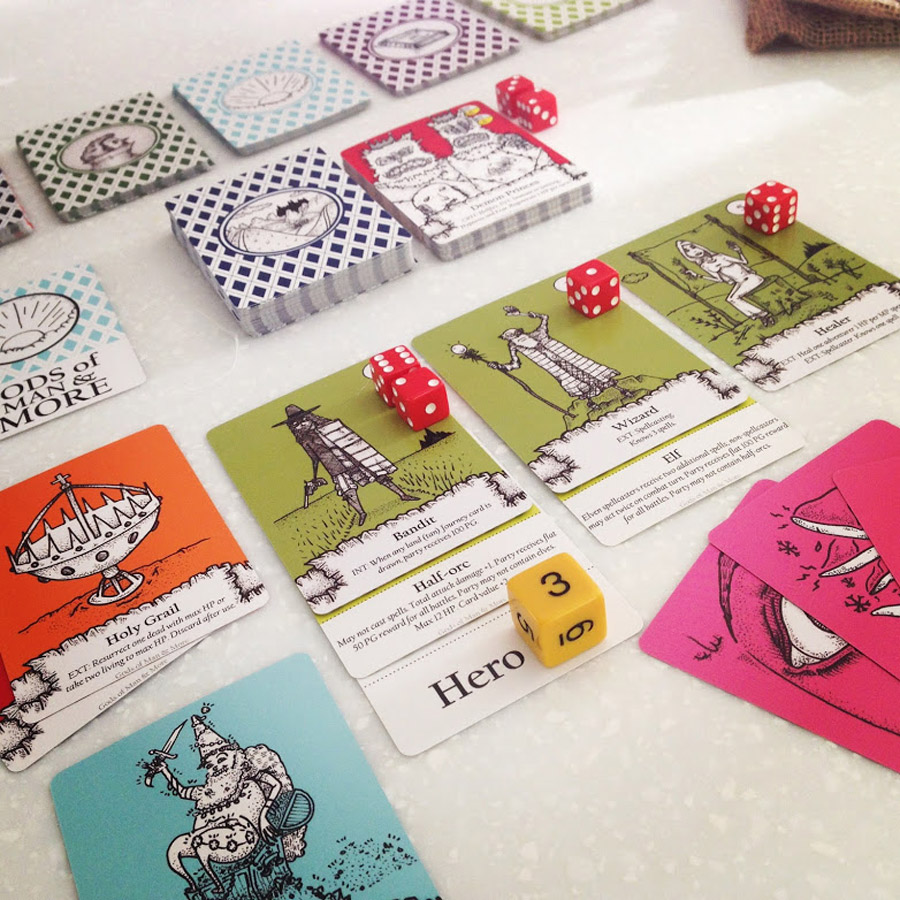
I’m planning a Kickstarter which I’d like to launch later this year to get the game out to all the people who’ve been asking me for a copy, so we’ll see how that goes. In the meantime I’m working on some other things which, also, will take a while for me to get out there. But as long as I’m creating, I figure it’ll all work out.
Photo credits: Graham Cranfield. Used with permission.
Did you like this story? Please share or comment. Go to this page to submit a story yourself. Subscribe to our online magazine here!
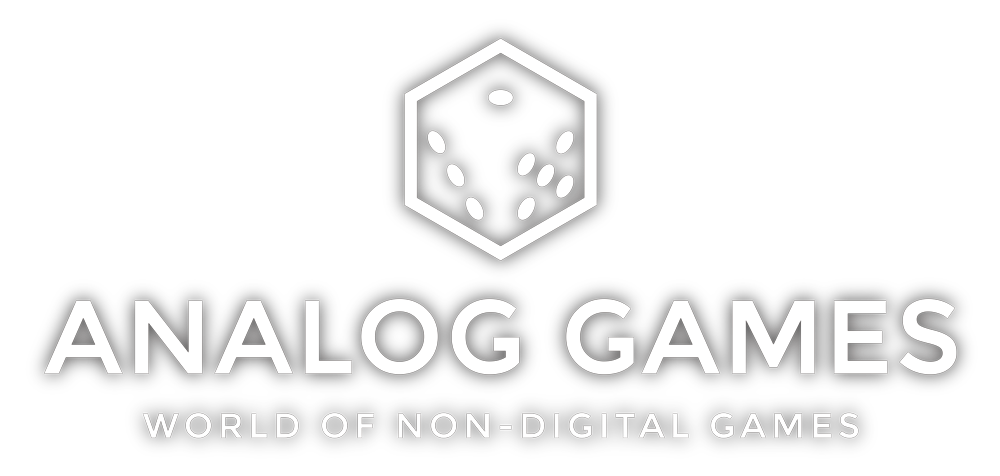
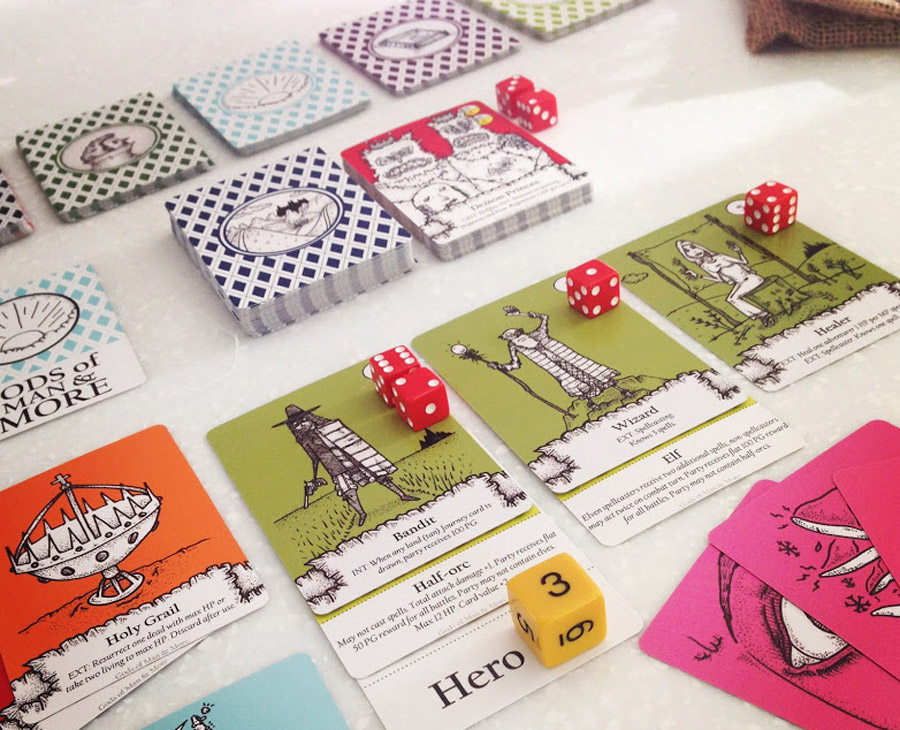
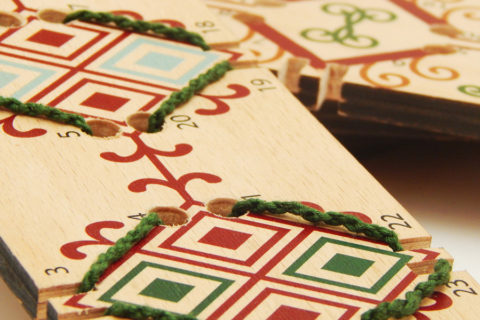
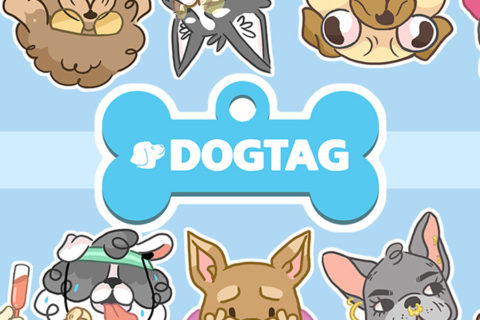
This looks really sweet! Thanks for sharing.
It looks good to me!
Do you have any more of these for sale??
Want
Looks amazing. I love the art design. If you end up wanting reviews for the kickstarter, I’d love to do one for you. You can check out my blog on wordpress if interested. 🙂
Very cool looking game. I’d love to pick up a copy… if you ever start a Kickstarter or decide to take orders directly.
Here’s hoping you could keep us informed on the Kickstarter status. Would be first in line to support this project!
I too love the look of this game and would support a Kickstarter for sure! Let me know when its up!!
Seconded. Reminds me of a mix between Choose Your Own Adventure and Munchkin. Would definitely by a burlap copy. Hope to see more distribution soon!
The kickstarter is live for the reprint https://www.kickstarter.com/projects/1574040857/heros-journey-home-old-school-fantasy-tabletop-car/description
The game is just unusual in appearance and meaning. As a connoisseur of this type of entertainment among friends, I rate the highest ball.
I really love sites like this, because I can tell you all about this dnp projects service, as it is one of the best, if not the best service providing such help, so if you’re a student you should definitely use it!
simple whiteboard that makes it easier to communicate visually. It’s a professional quality whiteboard that you will love writing on, drawing on, or just storing in your bank.Clcik on https://getblogo.com/differences-between-a-duplex-and-a-townhouse/
Hero’s Journey Home imagined by Movieclips is a film that tells the tale of two protagonists, who embark on a journey to meet the hero within themselves. Here you check this Landscaping ideas nz and get more new ways for ideas of landscapes. The film is vague at times, with occasional gaps for what is promising to be the core point of your story and perhaps some answers to questions you have yet to ask yourself.
In some countries, board game shelves are seen as part of the furniture and are often found in living rooms and game rooms. In other countries, they can be found in libraries and museums, preserving the history of the game and providing a way for people to access it. They can also be found in stores, allowing for people to purchase a game and learn about its rules and strategies. No matter where they are, board game shelves provide an important service for preserving the history of a game and for teaching people how to play it.
Your article helped me a lot, thanks for the information. I also like your blog theme, can you tell me how you did it?
Excellent content. Your style of presentation is unique.
Well researched and written post. Your post is very helpful.
one of the best
Take a bath and you’ll be amazed at how beneficial it could be in many ways like regular circulation of blood and skin rejuvenation. You can find the best spa with hot massage therapists in female to male body massage centres madipakkam
Massage is a soothing full body massage in bangalore using gentle strokes that promote relaxation and ease tension in the muscles..
We have highly experienced Hot Massage Therapists waiting to assist you. They can assist in relieving any tension or pain in your body. They will also ensure your peace of mind with their evening companionship. you can take advantage of all their services in female to male spa near me 24 hours center
Massage of the female to male body massage home service in kilambakkam will improve joint flexibility and mobility and reduce the chance of injuries. Don’t be delay in visiting our center to receive appropriate care of your body
When you’ve finished our body to body massage spa in punjagutta , try relaxation and go the tension. You are focused on your breath and the sensations that you are experiencing. Come and experience the sensations.
Thank you because you have been willing to share information with us. we will always appreciate all you have done here because I know you are very concerned with our. spbo live score
Want to enjoy spa service without any time barriers then b2b massage near me by izspa is perfect solution for you. Book your schedules now.
It’s a game. Five dollars is free. Try it It’s not an easy game
->-> 토토사이트
It’s a game. Five dollars is free. Try it It’s not an easy game
->-> 카지노사이트 .COM
It’s a game. Five dollars is free. Try it It’s not an easy game
->-> 카지노사이트 .COM
It’s a game. Five dollars is free. Try it It’s not an easy game
->-> 토토사이트 .COM
Thank you because you have been willing to share information with us. we will always appreciate all you have done here because I know you are very concerned with our. KUDA77 LINK SLOT
Your content is very interesting. I am very impressed with your post. I hope to receive more great posts.Mortal Kombat Merch
What a thrilling post, you have pointed out some excellent points, I as well believe this is a superb website. I have planned to visit it again and again. stenogramy
I have seen some great stuff here. Worth bookmarking for revisiting. I surprise how much effort you put to create such a great informative website. Your work is truly appreciated around the clock and the globe. Syair Cambodia
Indilens Web Solutions Succeed! It could be one of the most useful blogs we have ever come across on the subject. Excellent info! I’m also an expert in this topic so I can understand your effort very well. Thanks for the huge help.
It is a fantastic post – immense clear and easy to understand. I am also holding out for the sharks too that made me laugh. seeking arrangement india
Your blog is too much amazing. I have found with ease what I was looking. Moreover, the content quality is awesome. Thanks for the nudge! caluanie muelear oxidize usa
Pretty nice post. I just stumbled upon your weblog and wanted to say that I have really enjoyed browsing your blog posts. After all I’ll be subscribing to your feed and I hope you write again soon! #humantraffickingsurvivor
I think that thanks for the valuabe information and insights you have so provided here. best australian online casino
축구중계 Thank you so much as you have been willing to share information with us. We will forever admire all you have done here because you have made my work as easy as ABC.
I know this is one of the most meaningful information for me. And I’m animated reading your article. But should remark on some general things, the website style is perfect; the articles are great. Thanks for the ton of tangible and attainable help. Oxibet88
It is an excellent blog, I have ever seen. I found all the material on this blog utmost unique and well written. And, I have decided to visit it again and again. 스포츠중계
Yes i am totally agreed with this article and i just want say that this article is very nice and very informative article.I will make sure to be reading your blog more. You made a good point but I can’t help but wonder, what about the other side? !!!!!!Thanks 스포츠중계
This is such a great resource that you are providing and you give it away for free. I love seeing blog that understand the value of providing a quality resource for free. 스포츠중계
This is actually the kind of information I have been trying to find. Thank you for writing this information. 해외축구중계
Wow, cool post. I’d like to write like this too – taking time and real hard work to make a great article… but I put things off too much and never seem to get started. Thanks though. 스포츠중계
maniaslot Wow, this is really interesting reading. I am glad I found this and got to read it. Great job on this content. I like it.
giftcardmall/mygift I think that thanks for the valuabe information and insights you have so provided here.
Thanks for sharing the post.. parents are worlds best person in each lives of individual..they need or must succeed to sustain needs of the family. 스포츠중계
Your work is truly appreciated round the clock and the globe. It is incredibly a comprehensive and helpful blog. dezynsekcja warszawa
Love to read it,Waiting For More new Update and I Already Read your Recent Post its Great Thanks. Manhood Plus Gummies
Wow, this is really interesting reading. I am glad I found this and got to read it. Great job on this content. I like it. Manhood Plus Gummies review
Great job here on _______ I read a lot of blog posts, but I never heard a topic like this. I Love this topic you made about the blogger’s bucket list. Very resourceful. Braintree Roof Washing
Pretty nice post. I just stumbled upon your weblog and wanted to say that I have really enjoyed browsing your blog posts. After all I’ll be subscribing to your feed and I hope you write again soon! blown double glazing and blown double glazing repair
The “Hero’s Journey Home” symbolizes returning after transformation, facing the familiar with new insight. The candyman coat could represent the hero’s protective armor or distinctive attire, shielding them during their journey. As they return home, this coat becomes a reminder of the trials overcome and lessons learned.
Wow, cool post. I’d like to write like this too – taking time and real hard work to make a great article… but I put things off too much and never seem to get started. Thanks though. restaurantes en madrid
The “Hero’s Journey Home” encapsulates the transformative quest that shapes character. Similarly, twitch graphics design plays a crucial role in creating a unique brand identity for streamers. Just as heroes evolve through challenges, effective graphics design enhances a streamer’s narrative, attracting viewers and fostering community connection in the digital realm.
Thank you for another great article. Where else could anyone get that kind of information in such a perfect way of writing? I have a presentation next week, and I am on the look for such information. 라오스 황제 골프 예약
A very excellent blog post. I am thankful for your blog post. I have found a lot of approaches after visiting your post. plataforma nova
Yes, I am entirely agreed with this article, and I just want say that this article is very helpful and enlightening. I also have some precious piece of concerned info !!!!!!Thanks. betflix999
Wow, What an Outstanding post. I found this too much informatics. It is what I was seeking for. I would like to recommend you that please keep sharing such type of info.If possible, Thanks. situs agen togel
RumahBola merupakan Agen Judi Bola Mix parlay dan Situs Slot online terpercaya dengan Menyediakan pasaran bola terlengkap di indonesia Situs bola parlay
Excellent blog! I found it while surfing around on Google. Content of this page is unique as well as well researched. Appreciate it. rajabandot login
Great post, you have pointed out some excellent points, I as well believe this is a very superb website. DINA189 SLOT
Thanks for your insight for your fantastic posting. I’m glad I have taken the time to see this. gold finder
Excellent post. I was reviewing this blog continuously, and I am impressed! Extremely helpful information especially this page. Thank you and good luck. csbola
RumahBola merupakan Agen Judi Bola Mix parlay dan Situs Slot online terpercaya dengan Menyediakan pasaran bola terlengkap di indonesia Situs bola parlay
RumahBola merupakan Agen Judi Bola Mix parlay dan Situs Slot online terpercaya dengan Menyediakan pasaran bola terlengkap di indonesia Situs bola parlay
Experience the freshness of the ocean with our Fresh Wild-Caught Pacific Halibut at freshfishmarket. Harvested from the Pacific’s cold waters, this firm, white fish is known for its mild flavor and delicate flakiness. Perfect for grilling, baking, or pan-searing, it’s a versatile seafood choice for any meal. <a href="horween leather jacket“>Fresh Wild-Caught Pacific Halibut
Thank you for some other informative website. The place else may just I get that kind of information written in such a perfect method? I have a venture that I am simply now running on, and I’ve been at the glance out for such info. more info
Enjoy the timeless taste of Gigi’s Classic Chex Party Mix usa! A crunchy, savory blend of Chex, pretzels, and nuts, this mix is perfect for any gathering. Available now at gigisgourmetsnacks. gourmet classic chex party mix
Thank you for some other informative blog. Where else could I get that type of information written in such an ideal means? I have a mission that I’m just now working on, and I have been at the look out for such information. szafy biale
Wow, cool post. I’d like to write like this too – taking time and real hard work to make a great article… but I put things off too much and never seem to get started. Thanks though. Maatpakken
Thanks for your post. I’ve been thinking about writing a very comparable post over the last couple of weeks, I’ll probably keep it short and sweet and link to this instead if thats cool. Thanks. تلگرام
Wow, cool post. I’d like to write like this too – taking time and real hard work to make a great article… but I put things off too much and never seem to get started. Thanks though. ดูอนิเมะ
Thanks for your post. I’ve been thinking about writing a very comparable post over the last couple of weeks, I’ll probably keep it short and sweet and link to this instead if thats cool. Thanks. bokep
The Hero’s Journey Home is such a powerful concept, reflecting both the physical and emotional aspects of returning to one’s roots. Much like the journey home, choosing the right products can provide comfort and satisfaction along the way. For those in the UK, Best Disposable Vape UK offers top-quality vaping options to enhance your experience. Thanks for sharing this inspiring journey!”
Wow, cool post. I’d like to write like this too – taking time and real hard work to make a great article… but I put things off too much and never seem to get started. Thanks though. xnxx
Thanks for your post. I’ve been thinking about writing a very comparable post over the last couple of weeks, I’ll probably keep it short and sweet and link to this instead if thats cool. Thanks. ดูหนัง
Thanks for your post. I’ve been thinking about writing a very comparable post over the last couple of weeks, I’ll probably keep it short and sweet and link to this instead if thats cool. Thanks. ดูหนังออนไลน์ hd
Locate your underground drainage systems with ease using our advanced drain location services. Ideal for construction or blockage issues, we provide precise results, saving time and effort. Drain Location Services
Wow, cool post. I’d like to write like this too – taking time and real hard work to make a great article… but I put things off too much and never seem to get started. Thanks though. ดูหนังออนไลน์ 2024
Thanks for your post. I’ve been thinking about writing a very comparable post over the last couple of weeks, I’ll probably keep it short and sweet and link to this instead if thats cool. Thanks. anime
Detect hidden pipe problems with our video inspection services. High-resolution cameras reveal blockages, cracks, or leaks, offering a clear solution for drain maintenance. Video Inspection Services
Hero’s Journey Home” evokes the classic narrative of a hero returning after a transformative adventure, symbolizing personal growth, reflection, and the value of the journey itself. It reflects the idea that every path, whether literal or metaphorical, shapes who we become. Similarly, choosing elfliq liquid offers a fulfilling and enjoyable experience, where every flavor choice adds to the journey of personal taste and satisfaction. Both highlight the power of progression and finding joy in the journey itself
Thanks for your post. I’ve been thinking about writing a very comparable post over the last couple of weeks, I’ll probably keep it short and sweet and link to this instead if thats cool. Thanks. Ấu dâm trẻ em
Thanks for your post. I’ve been thinking about writing a very comparable post over the last couple of weeks, I’ll probably keep it short and sweet and link to this instead if thats cool. Thanks. anime-haru
Thanks for your post. I’ve been thinking about writing a very comparable post over the last couple of weeks, I’ll probably keep it short and sweet and link to this instead if thats cool. Thanks. porno
Thanks for your post. I’ve been thinking about writing a very comparable post over the last couple of weeks, I’ll probably keep it short and sweet and link to this instead if thats cool. Thanks. pornoterupdate
Keep your home sparkling with celescleaningcompany’s Standard Cleaning services in San Francisco. Perfect for regular upkeep, our team handles dusting, vacuuming, mopping, and sanitizing to ensure a fresh and inviting space. Book today for a reliable and thorough cleaning experience you can trust. Standard Cleaning in San Francisco
That’s the reason it is advisable that you need to right inspection earlier than writing. You can set up a lot better present with this. pornhub
Thanks for your post. I’ve been thinking about writing a very comparable post over the last couple of weeks, I’ll probably keep it short and sweet and link to this instead if thats cool. Thanks. Bali gift manufacture
Wow, cool post. I’d like to write like this too – taking time and real hard work to make a great article… but I put things off too much and never seem to get started. Thanks though. Herpafend
Wow, cool post. I’d like to write like this too – taking time and real hard work to make a great article… but I put things off too much and never seem to get started. Thanks though. cafe canggu bali
Thanks for your post. I’ve been thinking about writing a very comparable post over the last couple of weeks, I’ll probably keep it short and sweet and link to this instead if thats cool. Thanks. Prostavive
Wow, cool post. I’d like to write like this too – taking time and real hard work to make a great article… but I put things off too much and never seem to get started. Thanks though. Slimberine
Thanks for your post. I’ve been thinking about writing a very comparable post over the last couple of weeks, I’ll probably keep it short and sweet and link to this instead if thats cool. Thanks. SUGAR DEFENDER
Wow, cool post. I’d like to write like this too – taking time and real hard work to make a great article… but I put things off too much and never seem to get started. Thanks though. SUGAR DEFENDER
Wow, cool post. I’d like to write like this too – taking time and real hard work to make a great article… but I put things off too much and never seem to get started. Thanks though. MAHADEWI77
Thanks for your post. I’ve been thinking about writing a very comparable post over the last couple of weeks, I’ll probably keep it short and sweet and link to this instead if thats cool. Thanks. k9win
Wow, cool post. I’d like to write like this too – taking time and real hard work to make a great article… but I put things off too much and never seem to get started. Thanks though. wesele kielce
Wow, cool post. I’d like to write like this too – taking time and real hard work to make a great article… but I put things off too much and never seem to get started. Thanks though. Prodentim
Thanks for your post. I’ve been thinking about writing a very comparable post over the last couple of weeks, I’ll probably keep it short and sweet and link to this instead if thats cool. Thanks. Tonic Greens
Plastic Granule Manufacturers Wow, cool post. I’d like to write like this too – taking time and real hard work to make a great article… but I put things off too much and never seem to get started. Thanks though.
Wow, cool post. I’d like to write like this too – taking time and real hard work to make a great article… but I put things off too much and never seem to get started. Thanks though. Onebet
RumahBola merupakan Agen Judi Bola Mix parlay dan Situs Slot online terpercaya dengan Menyediakan pasaran bola terlengkap di indonesia Situs rumahbola
Thanks for your post. I’ve been thinking about writing a very comparable post over the last couple of weeks, I’ll probably keep it short and sweet and link to this instead if thats cool. Thanks. ดูหนังออนไลน์
That’sthe good reason marketing and advertising that you really best suited assignments prior to making crafts. It might be conceivable to put in writing advanced advertisment in such a. ซื้อหวยออนไลน์เว็บไหนดี
Liêng at Pbv88 lets you showcase your skills and tactics in intense matches against top-notch players.
Thanks for sharing. I read many of your blog posts, cool, your blog is very good.
Can you be more specific about the content of your article? After reading it, I still have some doubts. Hope you can help me.